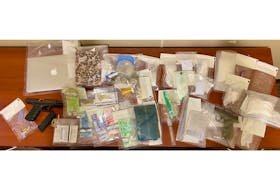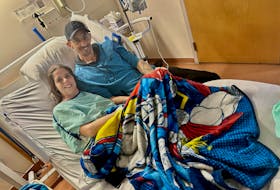At just three weeks old and still dependent on his mother for food, a porcupine pup was discovered by a local family’s curious pet dog at a critical point in his survival.
“He looked dirty, he had mud in his hair, he was cold, had lice, skinny and sad looking,” said veterinarian Helene Van Doninck of the Cobequid Wildlife Rehabilitation Centre, about the condition of a pup that has been recuperating under her care.
“He had his eyes closed and just wasn’t looking well.”
She said this time of year it is not uncommon for porcupine pups to be left alone for short periods of time. They are too slow to keep up with their parents, so mothers stash them in “safe places” like under tree roots or holes in the ground so they can forage for food, then return to their young to feed them.
The veterinarian believes, due to his condition and the parent’s failure to return to his hiding spot, he was orphaned.
Since arriving at his new temporary home, ‘Porc,’ has been undergoing treatment for his health conditions and has garnered the attention of international media with his eating habits. A YouTube video Feeding the Baby Porcupine, posted by the centre, shows the pup drinking a mixture of strawberry yogurt and simulated puppy milk from a syringe.
“We did get some calls from news agencies,” said Van Doninck. The video was shown on the New York Daily News’ website and Laughing Squid. The centre has also received requests from Good Morning America and Fox News requesting permission to air it.
The 73-second clip now has more than 40,200 views.
The pup has a soft underbelly and is handled only during feedings, which are done with the syringe to limit contact and for safety.
The centre started a YouTube channel to showcase some of the animals cared for there.
“It’s just another tool for marketing and raising awareness of what we do,” said centre co-founder Murdo Messer. “We don’t do tours and we don’t invite the public into it, so it is one way to show people what we do.”
There are currently more than 100 videos on YouTube posted by the centre showing things such as active releases, surgeries and feedings.
Porc is the fourth porcupine to be received at the centre since it opened, located on a hilltop in Hilden.
Van Doninck said while porcupines are the second largest rodent in Canada, they are misunderstood.
“They are cool little animals,” she said. “There are a lot of myths about them that are unwarranted.”
She said for most people, the only contact they have with the nocturnal animal is spotting them dead on the side of the road.
The veterinarian describes them as “very gentle creatures.” She said the myth that porcupines throw their quills is false, but rather if something comes into contact with them, such as a dog’s nose, they will stick.
For now, Porc will remain in the centre’s care drinking the simulated milk used to nurse puppies mixed with yogurt to make it more palatable.
Typically, porcupines stay with their mothers for about two months before heading out on their own, said van Doninick, so they will provide care and food until their “star guest” is able to survive on his own.
At just three weeks old and still dependent on his mother for food, a porcupine pup was discovered by a local family’s curious pet dog at a critical point in his survival.
“He looked dirty, he had mud in his hair, he was cold, had lice, skinny and sad looking,” said veterinarian Helene Van Doninck of the Cobequid Wildlife Rehabilitation Centre, about the condition of a pup that has been recuperating under her care.
“He had his eyes closed and just wasn’t looking well.”
She said this time of year it is not uncommon for porcupine pups to be left alone for short periods of time. They are too slow to keep up with their parents, so mothers stash them in “safe places” like under tree roots or holes in the ground so they can forage for food, then return to their young to feed them.
The veterinarian believes, due to his condition and the parent’s failure to return to his hiding spot, he was orphaned.
Since arriving at his new temporary home, ‘Porc,’ has been undergoing treatment for his health conditions and has garnered the attention of international media with his eating habits. A YouTube video Feeding the Baby Porcupine, posted by the centre, shows the pup drinking a mixture of strawberry yogurt and simulated puppy milk from a syringe.
“We did get some calls from news agencies,” said Van Doninck. The video was shown on the New York Daily News’ website and Laughing Squid. The centre has also received requests from Good Morning America and Fox News requesting permission to air it.
The 73-second clip now has more than 40,200 views.
The pup has a soft underbelly and is handled only during feedings, which are done with the syringe to limit contact and for safety.
The centre started a YouTube channel to showcase some of the animals cared for there.
“It’s just another tool for marketing and raising awareness of what we do,” said centre co-founder Murdo Messer. “We don’t do tours and we don’t invite the public into it, so it is one way to show people what we do.”
There are currently more than 100 videos on YouTube posted by the centre showing things such as active releases, surgeries and feedings.
Porc is the fourth porcupine to be received at the centre since it opened, located on a hilltop in Hilden.
Van Doninck said while porcupines are the second largest rodent in Canada, they are misunderstood.
“They are cool little animals,” she said. “There are a lot of myths about them that are unwarranted.”
She said for most people, the only contact they have with the nocturnal animal is spotting them dead on the side of the road.
The veterinarian describes them as “very gentle creatures.” She said the myth that porcupines throw their quills is false, but rather if something comes into contact with them, such as a dog’s nose, they will stick.
For now, Porc will remain in the centre’s care drinking the simulated milk used to nurse puppies mixed with yogurt to make it more palatable.
Typically, porcupines stay with their mothers for about two months before heading out on their own, said van Doninick, so they will provide care and food until their “star guest” is able to survive on his own.








